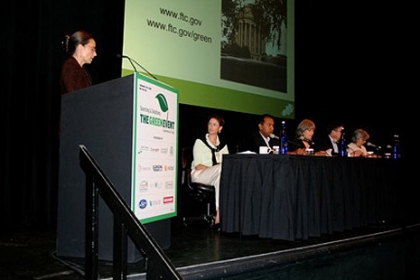The ‘Green Stamps‘ panel helps attendees learn about what is available in the market to support their green claims.
I was recently on Broadway — not in the latest production of West Side Story — but at the Hudson Theatre for The Green Event. The two-day conference brought together textile industry stakeholders — suppliers, buyers, designers, and regulators — to share ideas for developing eco-conscious practices across the board.
I had an opportunity to participate on the ’Creating Green‘ retail panel alongside Marks & Spencer’s veteran cotton expert, Graham Burden. I shared Continuum’s insights about the consumer perspective on sustainability, sparking a conversation about the need to consider the demand-side of the sustainability equation. My talk followed an excellent keynote by Andrew Winston, author of Green to Gold and founder of Winston Eco-Strategies. Mr. Winston spoke passionately about the business case for sustainability, citing numerous examples of companies that had achieved true competitive advantage by identifying upside opportunities or eliminating downside risks in this space.
Ian Yolles, a co-founder of the novel sustainable clothier, Nau, was one of the most compelling voices at the event. He explained how he and a few friends (ex-execs from Nike and Patagonia) got together in 2005 to create a new form of ’business activism‘ by founding a company on the ideals of sustainability and social responsibility. Their corporate bylaws turned the traditional clothing retail model on its head in a number of ways, including: mandating the use of more sustainable materials and processes (for example, recycled PET soda bottles become recyclable polyester garments), providing a 5% donation of sales to non-profit philanthropy (to be specified by customers at POP) and selling directly to customers through an assortment of low-impact retail outlets (both the internet and their novel store-meets-internet ’webfronts‘).
In 2007, Nau’s aggressive strategy met an adverse twist of financial fortune, forcing the company to close its doors after just one year in business. However, Ian explained that the abiding support of their nascent customer base (via blogs, emails, letters, and phone calls) helped Nau quickly find a partner who recognized the intrinsic value of their brand. Nau officially re-opened for business on October 15, 2008.
The event rounded out its message of pragmatic optimism with informative presentations and panel discussions featuring novel eco-friendly materials from suppliers such as Dupont, Lenzing, and Unifi. Regulators and policymakers from the Federal Trade Commission, Carbon Trust, the Organic Exchange, Oeko-Tex, and others were also on hand to help attendees understand how to certify their products and make honest claims about them to their consumers.
All in all, the conference was a great opportunity to share success stories and inspire industry-wide collaboration to further the sustainability effort.
Image credit: Formula4Media

